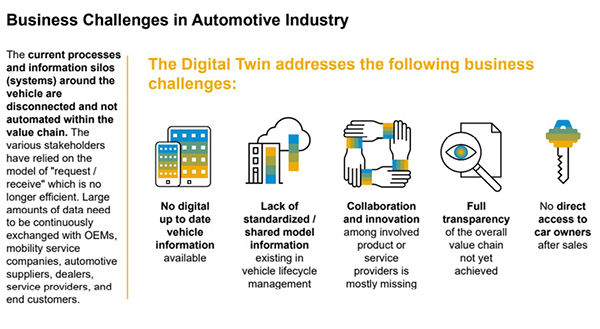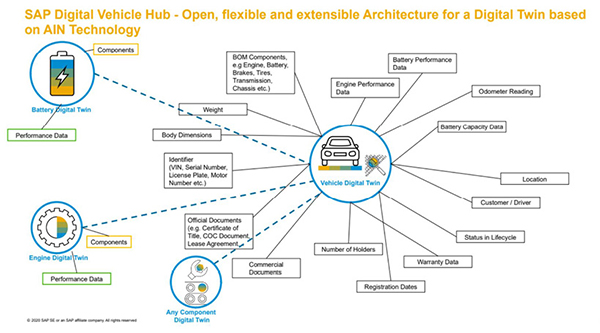
Fig. 1: Building a digital thread for a connected car means tapping into multiple data streams from vehicles, transportation infrastructure and a raft of mobile devices and services. Image courtesy of Siemens Digital Industries Software.
Latest News
July 23, 2021
The emergence of the connected car marks a key stage in the evolution of the automobile, putting digitization squarely in the driver’s seat. To successfully make the transition, however, the automotive designer must bring the full power of digital thread to bear (Fig. 1).
From the beginning, the main challenge confronting designers of connected cars has been the formulation of a clear picture of what they were creating. Connected car technology has made vehicles much more than transportation platforms. By adding connectivity and extensive data collection to the mix, carmakers have created an opportunity to spark the same level of consumer enthusiasm that electronics companies have done with their smart products.
To deliver on this promise, however, the designer must fundamentally rethink the automotive environment. In-car features have shifted from hardware-based functionality to software-defined capabilities. These software-based features increasingly take the form of rich web services.
To complete this digital transformation, carmakers must modify their processes and operations, and tailor the changes to produce vehicles that better meet the evolving demands of today’s consumers. This means that engineers must be able to identify and understand the usage patterns and preferences of vehicle occupants, with an eye on delivering the optimum user experience.
Engineers now have a better chance of achieving this because of the increasing availability of location- and time-specific sensor data. The challenge here is to create an infrastructure that can aggregate and refine data, allowing globally distributed stakeholders to leverage data that comes in a broad spectrum of formats, from a plethora of sources and engineering domains. This is where the digital thread comes into its own.
Creating a Window for Designers
By harnessing digital thread, automotive engineers gain access to vast pools of information associated with the connected car, allowing them to evaluate different configurations of the software, and mechanical and electrical parameters.
As the vehicles operate, the thread collects and filters information, constantly tapping the changing data streams as the cars mature and the mobility environment changes. This can be done for thousands, even millions, of vehicles.
“This operating history of every connected car is a treasure trove of information to support next-generation product development,” says Jason Kasper, product marketing manager at Aras. “The information can provide insight into such things as driving habits, quality issues, service history and maintenance considerations.”
In the past, carmakers attempted to compile similar histories by performing time-consuming usage studies, called customer correlation studies. Now, with the digital thread, development teams gain access to information that enables them to enrich, analyze and sanitize data much more quickly (Fig. 2).
“We are doing this for a major [original equipment manufacturer (OEM)] in Germany to extract usability information and useful insights into energy management, performance optimization and remaining useful life,” says Nand Kochhar, vice president, automotive and transportation industry, at Siemens Digital Industries Software.
New Points of Interest
As connected car technology has matured, three types of data have grown in importance, capturing the attention of automakers. These are categorized as remaining useful life, energy management and advance driver-assisted systems (ADAS) and automated vehicle (AV) systems.
In this context, remaining useful life data helps engineers to understand the dynamic use cases. An example of this might be: “When will the suspension system fail?”
Energy management information, on the other hand, allows the design team to improve battery consumption, optimize power versus range tradeoffs and maximize overall power management and efficiency. This type of data is especially important now that the industry is making the transition to electric vehicles.
Furthermore, ADAS and AV data helps development teams account for new regulatory requirements, such as automatic braking, which is becoming compulsory for U.S. vehicles in 2022.
“Analyzing this data enables teams to discover the causes of issues like phantom braking,” says Kochhar.
Richer Details, Living Designs
To ensure that engineers reap the full benefit of the digital thread, data must be collected across the vehicle’s entire lifecycle, beginning at the earliest stages of design and development and continuing through the production, service and usage phases. Each lifecycle phase delivers unique and essential data, which contributes to the richness of the resulting digital twin (Fig. 3).
For example, engineering data describes the product’s structure, its variants and dependencies, and software and sensor requirements—all of which describe the product and its functionality. Similarly, manufacturing data defines the concrete instance and configuration of the built product, including the individual parts used during manufacturing.
The digital thread combines and links these data streams so that they work in tandem. This enables more comprehensive coverage of the design.
Making Smarter Choices
The data provided by the thread is the material from which models and simulations of connected cars and services are made. Parameter inputs come from an increasing number of sources, all made available through the digital thread.
As the connected data pool grows, analytics can better guide the setting of tolerance limits, improving the accuracy of models and simulations.
“Teams create their designs based on assumptions, but the digital twin enables them to replace those assumptions with real-world facts,” says Mark Taber, vice president of go-to market and marketing at PTC. “This enables them to test their designs against the actual conditions the vehicles see in the real world and to better refine their design choices.”
The attraction of digital thread lies in the fact that it promises engineers access to the data they need, when they need it. The challenge, however, is getting the quality of data required.
The biggest obstacle here is the sheer amount of data to be processed and analyzed. A connected car produces a tremendous amount of data every second. This makes it critical to sanitize and filter data.
For example, some types of data are easy to manage. For instance, basic vehicle performance data can be event-based, and this makes it easy to identify.
On the other hand, to create useful information from specific interactions between a connected car and other factors (e.g., vehicles, infrastructure and web services) is another matter. This requires a system that can cull out and integrate useful information from diverse systems. To accomplish this, significant computing power must be available at the edge.
All of this may seem doable, but there’s a catch. As automotive companies digitize their processes and operations, they have encountered bottlenecks. These often stem from homegrown software, spreadsheets and data management systems designed decades ago to be completely independent of external platforms. This is where a division of labor between edge and cloud systems provides a solution.
Cloud and Edge Collaboration
These two systems working together provide the muscle required to break down data silos, deal with the data deluge and extract useful information continuously.
For example, edge computing resources on the connected car—enhanced with artificial intelligence—can filter incoming data, identifying and isolating useful or relevant information. This translates into pushing out performance, usage and condition summaries. By doing this, edge systems reduce the volume of data to be analyzed and lessen the demands placed on communications infrastructures.
“Edge technology enables decentralized processing and analysis of data, such as data produced by vehicle sensors, to reduce the volume of data that must be transferred,” says Hagen Heubach, global vice president and head of the automotive industry business unit at SAP. “Consequently, transfer times for a connected car’s data are shortened, and this raises service quality significantly.”
 Fig. 2: Digital thread technology provides connected car designers and manufacturers with the means to break away from and move beyond the obstacles inherent with traditional automotive design, manufacturing and data management practices. Image courtesy of SAP.
Fig. 2: Digital thread technology provides connected car designers and manufacturers with the means to break away from and move beyond the obstacles inherent with traditional automotive design, manufacturing and data management practices. Image courtesy of SAP.Upon receiving partially processed data from edge devices, cloud systems can further scrub and enhance the data as needed. Cloud systems also provide the network and platforms that vendors and product designers use to collaborate as they develop, launch and update the vehicle and supporting services.
An example of this can be seen in the freight industry, where companies have discovered that driving style greatly determines tire wear and tear. Aided by the insights enabled by digital thread and digital twin, these companies now access data that helps them to schedule predictive maintenance and preemptive repairs.
Security Becomes a Real Concern
As connectivity and big data become integral parts of this generation of vehicles, carmakers, their supply chain partners and connected car development teams must contend with a new issue: cybersecurity.
The majority of cars today are very communicative, with each vehicle producing an enormous amount of data from interior and exterior sensors. Bundling technical and personal usage data can greatly help connected car designers, providing detailed insights about the occupants and their behavior, as well as the success or failure of the vehicle’s design.
Car companies and consumers, however, can pay a high price for these insights. The increased accessibility to these large pools of data exposes connected car control systems and their owners’ personal data to cyberattacks. In addition, penetrations of the digital twin during the product development phase can affect the long-term profitability of the OEM through the disclosure of intellectual property to a competitor.
“When I worked for a previous employer, an innovative engine design was disclosed to our competitors a few years before launch, allowing them to respond in the market, causing an estimated $1 billion loss,” says Rick Sturgeon, senior director of transportation and mobility at Dassault Systèmes. “During the development of the product and especially the field service, we need to both protect and be prepared to respond to security breaches. A system monitoring all the other systems for out-of-range conditions or actions is a good first step beyond conventional firewall prevention.”
In addition to system monitoring, the industry is working to expand established security enhancement measures to protect connected vehicles.
“To ensure that user privacy is respected, the use and further development of technologies for anonymization, integrated encryption and authentication will be key offerings from manufacturers and brands,” says SAP’s Heubach.

Paralleling these efforts is the industry’s drive to cultivate standards and a stronger regulatory environment. Having a common trusted platform is critical. Standards bodies have already done a lot of work on security standards and a common industry model. An example of this is in ISO/SAE 21434, which addresses road vehicle cybersecurity engineering through the improvement of software lifecycle management.
Driving the Digital Thread Forward
In the past, cars were primarily a mechanical device that you could take apart and put back together, confident that it would work. Connected cars, on the other hand, represent an amalgam of hardware, software, communications and cloud components, making them much more complex.
Creating a digital thread of the connected car, including data from its mobility environment, allows carmakers and development teams to test many options and optimize the vehicle and associated services as they mature. This minimizes development costs and rework. It also provides a significant reduction of the product’s development cycle and boosts customer acceptance.
User requirements are also validated early in the development process, ensuring an optimized customer experience. Even after the vehicle enters service, the thread enables car manufacturers to improve maintenance and continually upgrade the product and introduce new services.
More Aras Coverage
More Dassault Systemes Coverage

More PTC Coverage
More Siemens Digital Industries Software Coverage
Subscribe to our FREE magazine, FREE email newsletters or both!
Latest News








